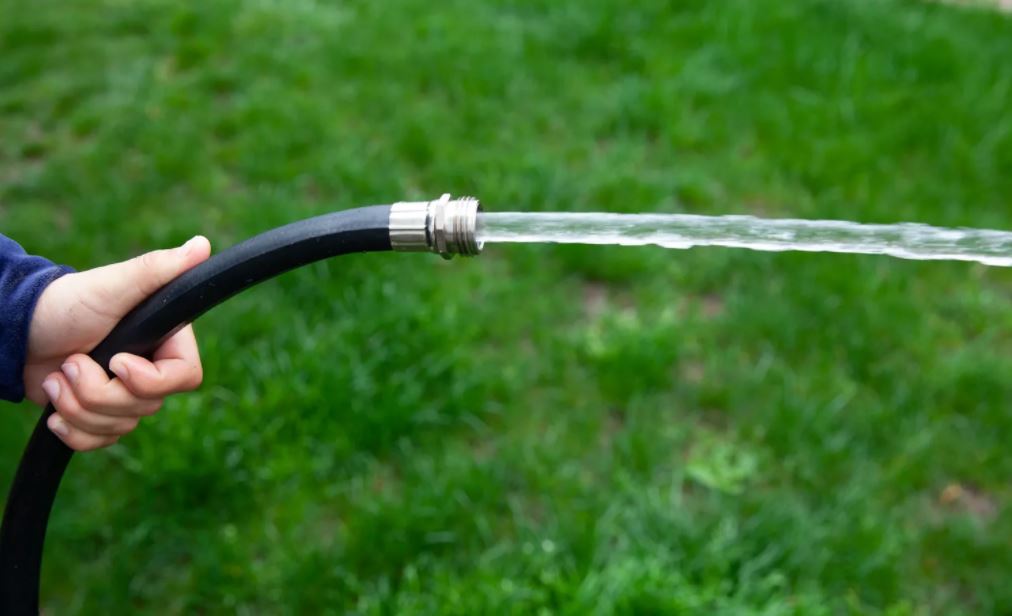🌊 What’s an Electric Current?
So far we’ve been talking about different types of static electricity, which is defined as an electric charge that is not flowing. Of course, that’s not entirely true—when it reaches a certain point, static flows all at once with a bang. But it doesn’t flow continuously, and that’s what separates static electricity from electric current.
Just like water, electricity can flow. And to us, flowing electricity (electric current) is the most useful kind, because we can make electricity do work for us when it moves in a continuous, controlled manner.

The Spruce / Sarah Vanbuskirk
Let’s go back to our water analogy and expand on it.
Imagine that you have two 20-gallon tanks close to each other; one is full and the other is empty. We are going to put a pipe between them, and there’s a valve that controls the flow of water through that pipe. What happens when we quickly open the valve all the way?
What did you observe?
- When we started, Tank 1 had all the water (that is, it had “higher potential”) and Tank 2 had no water (“lower potential”).
- When the valve was opened, water flowed from Tank 1 into Tank 2 until they both had the same amount of water, when the flow stopped (even though the valve was still open). We say that both tanks now have “equal potential.”
- Because these are both 20-gallon tanks and the first was full to start, 10 gallons of water total flowed through the pipe to reach equal potential.
- It took 2 seconds total for that amount of water to flow through the pipe, because any pipe can only flow so much water at a time.
This means we can calculate the rate of water flowing through the pipe in gallons per second, by dividing the number of gallons that flowed by the time it took for the water to move through the pipe. We find that 10 gallons in 2 seconds gives us a flow rate of 5 gallons per second. “Gallons per second” is a measure of the flow of water through a pipe that size, with these specific tanks.
How does this experiment relate to electricity?
It’s actually a very good comparison, because a battery is like two tanks, one with more “water” (which is actually an electric charge) than the other. The two “tanks” in a battery are actually called half-cells, but you can think of them as tanks for electrons. Which is just another way of saying that each half-cell stores a certain amount of electric charge (which we can measure in coulombs).
When one half-cell of a battery has more electrons than the other half-cell, we say that the battery is “charged” and capable of doing work.
When we connect a wire between the two ends, or terminals, of a battery, the charge flows from one “tank” in the battery to the other “tank” until both “tanks” have the same number of electrons. When we reach this point, we say that the battery is “discharged” and is no longer capable of doing work—unless it’s rechargeable, which means we can move electrons back up to the first tank and do more work.
Like the actual water tanks, the half-cell in the battery with more electrons is said to be at a higher potential. We call this “the positive end” or “the positive terminal” of the battery, and it is usually (but not always) marked with a “+” sign. Sometimes it is also marked in the color red, to help you differentiate it better.
The half-cell with fewer electrons is said to be at lower potential. As you probably guessed, we call this “the negative end” or “the negative terminal” of the battery, and it may be marked with a “-“ sign, if it is marked at all. Negative terminals are sometimes marked in the color black.
In our water analogy, the pipe between the water tanks is equivalent to the wire between the battery’s two ends or terminals. In reality, metal wires serve as pipes to carry electrons.
Let’s see how this works in an electric circuit:
What did you observe?
- When we started, the positive half-cell had 8 coulombs of charge and the negative half-cell had none. Like the water tank, the positive half-cell had higher potential than the negative half-cell.
- When we turned on the switch, which is just like opening the valve between the two tanks, electricity started to flow through the wire connecting the two half-cells of the battery. Along the way, we made it pass through a light bulb so that the electricity would do work for us.
- As long as there was more potential in the positive half-cell, electricity flowed and the bulb was lit.
- As soon as both half-cells had the same charge, and therefore the same potential, the electricity stopped flowing and the bulb went out. We have now discharged the battery, and unless we can recharge it, it won’t do any more work.
- Like a water pipe, only so much electricity can flow through a wire and other components during a given time. Here, it took 4 seconds for 4 coulombs to flow through the light bulb, which means that we can calculate a flow rate of 1 coulomb per second (4 coulombs divided by 4 seconds).
- “Coulombs per second” is a measurement of the electric current flowing through this wire, exactly like “gallons per second” was a measurement of the current of water through a pipe.
- The measurement “coulombs per second” is used so often in the study of electricity that it has its own name: the ampere, more commonly called an “amp.” Like all standard scientific units, it has an abbreviation as well, which is the capital letter “A.”
In fact, knowing the amount of current flowing through a circuit is so important that we have a tool to measure that current. It’s called an ammeter, and we’d like to show you how it works in our little electric circuit animation.
What did you observe?
- To set up an ammeter, we connect it so that all the current flows through the ammeter itself. We put it in line with the other components of the circuit we’re measuring. We say that the ammeter is connected in series with the bulb.
- How we connect the ammeter is very important, and we’ll show you more on that later. But for now, the important thing to remember is that it cannot be the only component in a circuit (besides the switch). That’s why we have a light bulb in the circuit with the ammeter.
- When we turned on the switch, current flowed exactly like before. The ammeter doesn’t affect the flow of electricity in a circuit, in a way we can measure.
- We see that as long as there is current flowing, the ammeter reads 1.0 amps, because we are passing one coulomb every second through the circuit.
- When the battery is dead (fully discharged), current goes to zero amps, and the light bulb goes out.
Let’s review!
We now know that we can measure the quantity of electricity in coulombs, just like we can measure the volume of water in gallons.
When water flows, we can measure the water current passing a given point in gallons per second. We can do the same thing with electricity, using coulombs per second, or amps.
Measuring the amperage in a circuit is very helpful—often necessary—to know, so we use a special measuring instrument called an ammeter to determine the amount of coulombs per second (amps) flowing past a given point in that circuit.
That’s pretty good—electricity really is like flowing water. But there are two more important concepts to grasp, and just like before, we can learn them from our water tank analogy.
🌟 KEY CONCEPTS
- Electric current, which is the amount of charged (the number of electrons) moving past any point in a circuit in a given amount of time.
- The unit of measurement for electric current is ampere, usually called “amp”.
- A is the abbreviation for amps.
- The instrument used to measure electric current is called an ammeter.
- Ammeters are connected end-to-end (in series) with other loads in a circuit.
